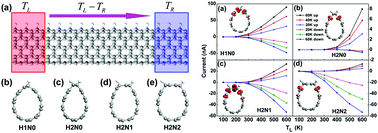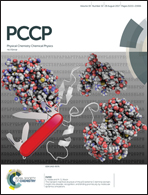Hydrogenated carbon nanotube-based spin caloritronics†
Abstract
Spin caloritronics has drawn much attention as it combines thermoelectrics and spintronics together. Carbon-based structures, such as graphene, have been found to exhibit different kinds of spin caloritronic features. However, a study of spin caloritronics in carbon nanotubes (CNTs) is still lacking. Using first-principles calculations, we investigate the spin-Seebeck effect (SSE) in partially hydrogenated CNTs. It is found that linear hydrogenation could make CNTs acquire magnetism and exhibit the spin-Seebeck effect. Moreover, an odd–even effect of the SSE is observed, where the even cases could be used as spin-Seebeck diodes. Further analysis shows that, it is induced by the difference of band structures, where the band structure of a tube is a combination of that of graphene-nanoribbon parts “divided” by hydrogenation. This mechanism could be extended to nanotubes with different diameters, showing great application potential. We believe that our results are very useful for the development of nanotube-based spin caloritronic devices.



 Please wait while we load your content...
Please wait while we load your content...